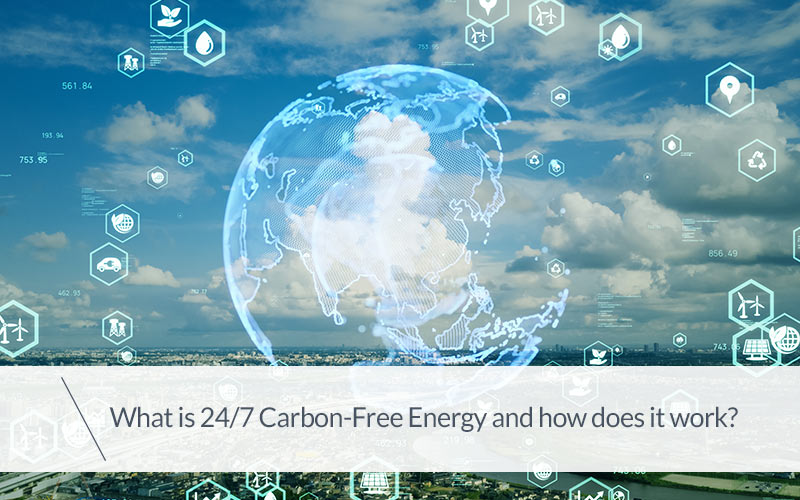
Total decarbonization, the environmental goal to be reached within just a few years from now, means that the world’s electric systems need to give up fossil fuels and aim instead at using renewable energies, to oppose the global climate warming currently underway.
Electricity production adds up to about 25% of greenhouse gases, onto which we should add another 21% generated by transport and buildings. Thus, complete decarbonisation of electric systems is key in halting climate change, with the potential to eliminate almost 50% of greenhouse gas emissions at a global level.
It’s an ambitious project, insofar it requires the production of clean energy 24/7/365, otherwise known as 24/7 Carbon-Free Energy (CFE), prospected by the ONU in collaboration with a group of energy purchasers, energy suppliers, governments, systems operators, solutions providers, investors and other organisation, which joined forces to accelerate the decarbonisation process of electricity networks by adopting, permitting and promoting non carbon-emitting energies 24/7.
Let’s dig deeper and understand what 24/7 Carbon-Free Energy is and how it works.
What is 24/7 Carbon-Free Energy?
The 24/7 CFE (Carbon Free Energy) target entails meeting a very specific goal, which is that every kilowatt-hour of electricity consumption is supplied from sources free from carbon emissions, every hour of every day, everywhere.
Free from carbon emission refers to all the energy that comes from electrical sources considered to be without carbon emission such as:
- wind
- sun
- nuclear
- geothermal
- hydroelectric
- other carbon free sources
Obviously, results will not be instantaneous, but the goal is an entirely decarbonised electrical system, as well as a different approach in energy procurement, supply and planning of environmental policies.
What obstacles are to be overcome in reaching this goal?
Some renewable energy sources, such as solar or wind-powered, are by nature intermittent. Simply stated, the sun isn’t always shining, and wind is unpredictable in its strength and duration.
To compensate for low or zero periods of energy production, or during peak demand, it is currently necessary to activate fossil-fueled mechanisms, fueled by coal, petroleum or natural gas.
Reaching a supply level of carbon-free clean energy that is able to satisfy 100% of the network demand, will take a sizable and global effort, inevitably accompanied by technological, economic, social and political challenges.
What are the 24/7 Clean Energy or CFE principles?
The principles at the basis of the 24/7 CFE project are listed in an ONU leaflet, as follows:
- Time-matched procurement: 24/7 CFE focuses on matching each hour of electricity consumption with carbon-free electricity generation. Hourly matching helps connect clean energy purchasing to underlying electricity consumption.
- Local procurement: 24/7 CFE means purchasing clean energy on the local/regional electricity grids where electricity consumption occurs. This is the only way to drive the electricity-related emissions for which a consumer is directly responsible to zero.
- Technology-inclusive: 24/7 CFE recognises the need to create zero-carbon electricity systems as fast as possible, and that all carbon-free energy technologies can play a role in creating this future.
- Enable New Generation: 24/7 CFE focuses on enabling new clean electricity generation, in order to support the rapid decarbonisation of electricity systems.
- Maximise System Impact: 24/7 CFE focuses attention on maximising emissions reductions and solving issues centered on the “dirtiest” hours of electricity consumption.
The benefits of 24/7 Clean Energy
According to an article in the World Economic Forum, 24/7 CFE may generate the following benefits:
- Effectively reduce or eliminate carbon emissions associated with electricity use by ensuring that hourly electricity consumption is being matched with clean energy generation. This solves the issues surrounding those that effectively become the ‘dirtiest’ hours of energy consumption, maximising emission reduction.
- Encourages development of mechanisms and technologies to ensure 24/7 clean energy. So that when companies value hourly clean energy, they have mechanisms, standards and technologies that are built to support that mission (such as real-time energy monitoring, energy storage and granular clean energy).
- Supports further investment in clean energy assets on electric grids by providing incentives for suppliers to always make renewable energy available in locations where renewables would have a larger impact on grid decarbonisation.
- Reduces market risk and increases ESG scores (Environmental, social, and governance). By matching demand on an hourly basis, companies ensure that their renewable energy consumption claims are true, minimising the threat of greenwashing allegations. Higher ESG scores also provide access to cheaper capital in a financial market eager to greenify investment portfolios.



